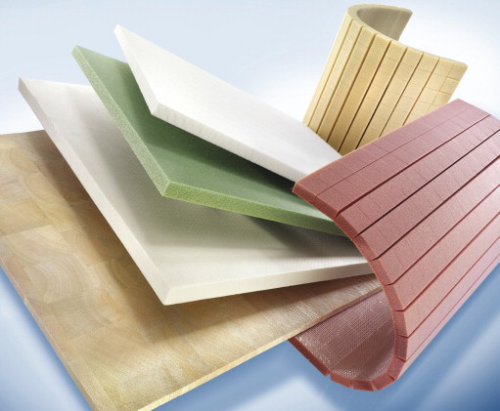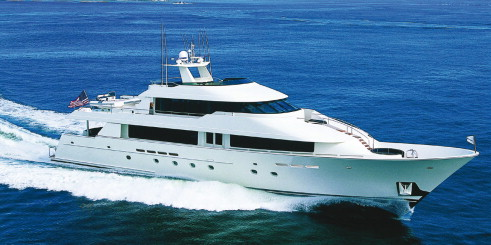

A typical structure consists of different parts which are loaded unequally. Different applications also require different characteristics. So why try to cover all these requirements with a single core material when combining different materials can significantly the reduce the total cost and weight of such structures.
Lightweight structures
When it comes to lightweight structures, manufacturing parts in a composite design is now an established technology in many markets. The marine industry discovered the advantages of composite materials more than 50 years ago.
In order to further decrease the weight of a part, composite technology offers the sandwich design principle – the introduction of a stiff but very low weight core material between two stiff skin layers. This principle increases the static height of the part, which leads to a significantly higher stiffness at reduced weight.
More and more manufacturers are successfully using sandwich construction in their load-carrying structures. Applications range from small parts such as hatches, covers and interior walls, to boat hulls and huge wind turbine blades. Many of these applications have been established over a number years and are still working very well, proving that the composite sandwich design principle successfully resists tough environmental conditions over the long term, and creating more demand for this technology.
Consequently the composite industry tried to catch up with market needs and has developed more and more materials suitable for use as a core in sandwich structures. There are many producers providing many different core materials, some of which are based on very sophisticated chemistry and processes. Each of these new product developments brings with it a unique characteristic and nowadays the sandwich composite manufacturer is in the comfortable situation of being able to choose the core material which best fits the requirements of their application from among a wide range of products.
But the world is not as simple and uniform as one may wish it to be. In each final product, be it a sailing yacht, a cargo container, a wind turbine blade or a city bus, there are different regions where different characteristics are required of a core material. While impact resistance is key in the slamming area of a boat, temperature resistance is required in its dark hull side. Good fatigue properties may be required in the transom, while high stiffness is desirable for a comfortable deck. Fire, smoke and toxicity (FST) rating is important in cabin interiors, while chemical resistance is necessary in the areas of the motor and gas tank.
Unfortunately, no single core material has all the above properties – let alone at an affordable price.
Intelligent combinations
What are the options then? You can go for a ‘one product fits all’ strategy, choosing the core material that meets all your different (and sometimes contradictory) requirements best – or let us say, least badly. This strategy is in most cases bound to produce a somewhat suboptimal result.
The second alternative is to combine different core materials in your application thus choosing the optimal core material for each different region of your part. Not only will you use different densities for the different stress levels in your part, you may also combine balsa wood with polyethylene terephthalate (PET) foam and light polyvinyl chloride (PVC) foam with high density fibre-reinforced foam, just what is best for your application.
This approach has two main advantages that most customers are eager to benefit from:
- your part will be cheaper: you don't need to pay for the high performing foam in a region of your part where a less costly alternative is equally suitable; and
- your part will be lighter: you will use the higher density and thus heavier core material only in parts where you expect high stresses, whereas in other regions you will go for a lighter, low density material.
The choice
Various structural core materials are provided by the core material producers. Each of them offers very specific characteristics (see Table).
| Core material | Main features | Main applications | Alcan Airex product |
| Standard cross-linked PVC | High stiffness & strength-to-weight ratio | General use: wind turbine blades, boat hulls & decks | AIREX C70 |
| High temperature resistant cross-linked PVC | High stiffness & strength-to-weight ratio, suitable for high processing & service temperatures | General use, where high temperatures are expected | AIREX C71 |
| PET | Good compression & shear properties, good temperature, fatigue & fire performance | Sandwich structures requiring good FST ratings: marine (interiors), road & rail (interiors & structure) | AIREX T90 |
| PET | Good compression & shear properties, good temperature & fatigue performance | General use, cost-sensitive applications: wind turbine blades, boat hulls & decks | AIREX T92 |
| PUR | High impact strength, very good formability | Cost-sensitive applications: wind turbines (nacelles), road (roof & covers), industry (covers) | AIREX C52 |
| Reinforced PUR | High mechanical properties, especially in shear & bending | Sandwich structures subjected to very high loads. Stand-alone foam panels. Marine (transoms, stringers, bulkheads), wind turbines (blade close-out), industry (containers) | AIREX PXc and PXw |
| Balsa | High strength & extreme stiffness to weight ratio | General use: wind turbine blades, boat hulls & decks | BALTEK SB |
| Linear PVC | Outstanding damage tolerance | Structures with risk of high impact loads: marine (boat hulls) | AIREX R63 |
| PEI | Outstanding FST ratings, excellent temperature performance & good mechanical properties to weight ratio | Sandwich structures requiring very good FST properties &/or good dielectric properties. Aerospace (interior), railway (structure & interior), industry (radar covers). | AIREX R82 |
For standard applications, the following materials are suitable:
- cross-linked PVC – standard, in densities as low as 40 kg/m3, up to 200 kg/m3;
- cross-linked PVC – high temperature resistant;
- PET – easy processing, fatigue resistant and superior FST properties;
- polyurethane (PUR) – industrial core;
- PUR – fibre reinforced core/stand-alone panel; and
- balsa wood – outstanding mechanical properties to weight ratio.
For more sophisticated applications, the following materials are available:
- linear PVC – damage tolerant; and
- polyetherimide (PEI) – superior FST and mechanical and radar properties.
All these different core materials will allow you to perfectly optimise your product. Whether you need high impact resistance, good fatigue characteristics, high temperature performance, high stiffness at low densities, good hot or cold formability, recyclability, excellent fire, smoke and toxicity properties, chemical resistance, outstanding dielectric properties, or just a ‘green’ product, you will find the right core material among the wide product range offered.
|
The first Westport 130 luxury yacht was completed in just 14 months and quickly led to the start-up of others. For the most efficient construction and safe operation, the company made no compromises in the choice of materials. Damage tolerance and stiffness are the most important properties when selecting core materials for such boats. “To build a great yacht, you must use the right materials,” says Westport General Manager, Daryl Wakefield. The Westport 130 is constructed in four modular components: hull; main deck; upper deck; and flying bridge. Each section is completely prepped and ready to paint at ground level before mounting to the hull. Damage tolerance and stiffness are the most important properties when selecting core materials for such boats. Westport was able to select the right core material for each sandwich part from a single source – Alcan Airex. In the hull, the section where extreme impact loads can occur, AIREX R63.140, a high impact strength structural foam core, is used. The excellent fatigue strength of R63.140 is said to guarantee the integrity of the sandwich structure even after many years of operation. Leading classification societies have recognised the outstanding dynamic qualities of R63 and lower the safety factor for this foam in their calculations for bottom panels of marine vessels, in comparison to other foam materials, by 15%. When using R63 the core thickness can be reduced by up to one third, which results in lower material costs. The ability of R63 foam to be cold-formed makes cutting unnecessary and consequently reduces resin consumption in the entire hull area, as no scim slits have to be filled with resin. This results in considerable savings in weight and cost. The result is a boat hull with less weight but maximum stiffnesss and exceptional dynamic strength for safety and comfort. The advanced vacuum-bagging techniques employed by Westport have produced more than 225 large hulls. The same production process is used for decks, stringers and superstructure. These parts are cored with AIREX C70 is densities between 40 kg/m3 and 200 kg/m3 and different thicknesses depending on the required strength and stiffness. AIREX cored sandwich parts are distinguished by their high compression strength, maximum bending stiffness, and they have an optimal combination of static and dynamic strength even under extreme sea conditions. Sandwich panels cored with BALTEK balsa wood of the Selects AL600 type are used for all interior deck soles, benefitting from the high compression load absorption capabilities of this core material. Generally, lightweight designing increases cost, but the Hybrid Core Concept®, as Alcan Composites Core Materials defines this option, offers just the opposite – weight reduction at reduced cost. |






